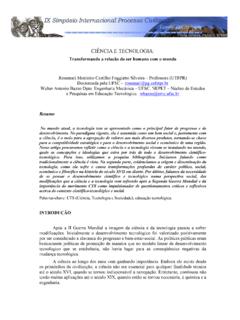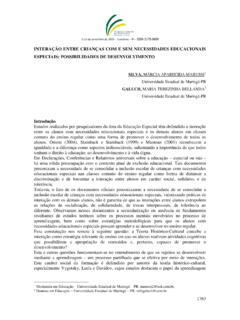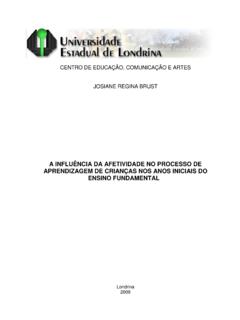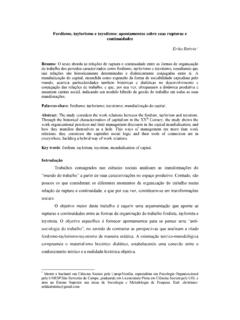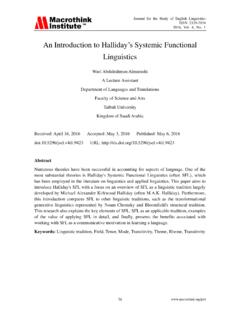Transcription of An Introduction to Functional Grammar - UEL
1 An Introduction to Functional Grammar T H I R D E D I T I O N. This page intentionally left blank An Introduction to Functional Grammar T H I R D E D I T I O N. Halliday Emeritus Professor of Linguistics University of Sydney, Australia Revised by Christian Matthiessen Professor of Linguistics Macquarie University, Australia Hodder Arnold A MEMBER OF THE HODDER HEADLINE GROUP. First published in Great Britain in 2004 by Arnold, a member of the Hodder Headline Group, 338 Euston Road, London NW1 3BH. Distributed in the United States of America by Oxford University Press Inc. 198 Madison Avenue, New York, NY10016. 2004 Halliday and Christian Matthiessen All rights reserved. No part of this publication may be reproduced or transmitted in any form or by any means, electronically or mechanically, including photocopying, recording or any information storage or retrieval system, without either prior permission in writing from the publisher or a licence permitting restricted copying.
2 In the United Kingdom such licences are issued by the Copyright Licensing Agency: Saffron House, 6 10 Kirby Street, London EC1N 8TS. The advice and information in this book are believed to be true and accurate at the date of going to press, but neither the authors nor the publisher can accept any legal responsibility or liability for any errors or omissions. British Library Cataloguing in Publication Data A catalogue record for this book is available from the British Library Library of Congress Cataloging-in-Publication Data A catalog record for this book is available from the Library of Congress ISBN-10: 0 340 76167 9. ISBN-13: 978 0 340 76167 0. 3 4 5 6 7 8 9 10. Typeset in 10 on Berling by Phoenix Photosetting, Chatham, Kent Printed and bound in India What do you think about this book? Or any other Hodder Arnold title? Please send your comments to Contents Preface ix Part I The Clause 1. 1 The architecture of language 3.
3 Text and Grammar 3. Phonology and Grammar 11. Basic concepts for the study of language 19. The location of Grammar in language; the role of the corpus 31. 2 Towards a Functional Grammar 37. Towards a grammatical analysis 37. The lexico- Grammar cline 43. Grammaticalization 46. Grammar and the corpus 48. Classes and functions 50. Subject, Actor, Theme 53. Three lines of meaning in the clause 58. 3 Clause as message 64. Theme and Rheme 64. Group or phrase complexes as Theme; thematic equatives 68. Theme and mood 71. Textual, interpersonal and topical Themes 79. The information unit; Given + New 87. Given + New and Theme + Rheme 93. Predicated Themes 95. Theme in bound, minor and elliptical clauses 98. Thematic interpretation of a text 100. CONTENTS. 4 Clause as exchange 106. The nature of dialogue 106. The Mood element 111. Other elements of Mood structure 121. MOOD as system; further options 134. Polarity and modality 143.
4 Absence of elements of the modal structure 151. Clause as Subject 154. Texts 158. 5 Clause as representation 168. Modelling experience of change 168. Material clauses: processes of doing-and-happening 179. Mental clauses: processes of sensing 197. Relational clauses: processes of being and having 210. Other process types: summary of process types 248. Circumstantial elements 259. Transitivity and voice: another interpretation 280. Text illustrations 303. Part II Above, Below and Beyond the Clause 307. 6 Below the clause: groups and phrases 309. Groups and phrases 309. Nominal group 311. Verbal group 335. Adverbial group, conjunction group, preposition group 354. Prepositional phrase 359. Word classes and group functions 361. 7 Above the clause: the clause complex 363. The notion of clause complex' 363. Types of relationship between clauses 373. TAXIS: parataxis and hypotaxis 383. Elaborating, extending, enhancing: three kinds of expansion 395.
5 Reports, ideas and facts: three kinds of projection 441. Clause complex and tone 482. Texts 484. 8 Group and phrase complexes 486. Overview of complexing at group or phrase rank 486. Parataxis: groups and phrases 489. Hypotaxis: nominal group 493. Hypotaxis: adverbial group or prepositional phrase 495. Hypotaxis: verbal group, expansion (1): general 497. vi Contents Hypotaxis: verbal group, expansion (2): passives 505. Hypotaxis: verbal group, expansion (3): causative 509. Hypotaxis: verbal group, projection 515. Logical organization: complexes at clause and group or phrase rank, and groups 521. 9 Around the clause: cohesion and discourse 524. The concept of text; logogenetic patterns 524. The lexicogrammatical resources of COHESION 532. Conjunction 538. Reference 549. Ellipsis and substitution 561. Lexical cohesion 570. The creation of texture 579. 10 Beyond the clause: metaphorical modes of expression 586.
6 Lexicogrammar and semantics 586. Semantic domains 593. Modality 613. Interpersonal metaphor: metaphors of mood 626. Ideational metaphors 636. References 659. Index 667. vii This page intentionally left blank preface Early in the new millennium, after the second edition of IFG had been on sale for some ve or six years, I was asked by the publishers: would I like to consider making some further revisions and preparing a third edition? I felt rather daunted by this prospect. I had worked very readily on IFG2, because there were features of the original which clearly needed revising, and I had some of the material already in hand. But this time, while there was no doubt that the book could be further updated and improved, I was not sure that I. had the necessary energy or expertise to undertake an IFG3. The obvious solution was to work in collaboration; and the obvious person to collaborate with was Christian Matthiessen, if he was willing and if he could nd the time.
7 He was; and he did. In the event, while I contributed a few sections to the revision, the lion's share of the work was taken on by Christian. The result is some way between a revision and a new book. More prominence has been given to the system networks which underpin the Grammar ; and there are many more text examples, because the systemic Functional model has been widely used in the analysis of discourse. Inevitably, therefore, the book has become rather longer than it was before. I hope this has not made it excessively recalcitrant to handle! It is still (as I said of the rst edition) a short Introduction , given the richness and complexity of what it is introducing the Grammar of a human language. Halliday The rst chapter has been largely rewritten, beginning with the motif of using a Grammar to analyse text, and then introducing the fundamental theoretical concepts that make up the architecture' of a language: axis, strati cation, instantiation, metafunction, composition.
8 The notion of constituency (syntagmatic composition), previously used as the way into the Grammar , is PREFACE. here given less prominence. Chapters 3 and 4 have been tidied up and extended; and Chapter 5 has been considerably rewritten, in order to make the very complex aspects of transitivity more accessible and to provide more support for text analysis. Chapter 7 has been extensively revised, with more material on the relationship between the clause complex and the rhetorical-relational organization of text; and what was Chapter 7. additional' has become Chapter 8, because Chapter 8 in its original form has disappeared, the content being incorporated into the chapters to which it is related (Chapters 1, 3, 4 and 7). Chapter 9 is still concerned with cohesion, but it has been expanded to include a discussion of instantial patterns in general in text and the presentation of the subsystems of cohesion has been reorganized so that it now starts with conjunction in order to foreground the link to clause complexing in the Grammar and rhetorical-relational organization in the discourse semantics.
9 Throughout the chapters we have tried, within the space available, to provide a sense of how the Grammar makes meaning in written and spoken text, illustrating the distinctive contributions made by the different options within a given system. This is one step in the direction of eshing out the relationship between Grammar and discourse semantics; but texts inevitably take up a good deal of space, and we have had to remove a number of examples we had originally included. These will nd their way into other publications, or be added to a new website that we are designing as a companion to IFG. This web companion to IFG will enable us to make available certain material from IFG2. that we were not able to include in this new edition. But it will also offer new material, including more text examples (spoken as well as written) and more discussion of particular points. Halliday & Christian Matthiessen x part I.
10 The clause This page intentionally left blank chapter one THE ARCHITECTURE OF LANGUAGE. Text and Grammar When people speak or write, they produce text. The term text' refers to any instance of language, in any medium, that makes sense to someone who knows the language (cf. Halliday and Hasan, 1976: Chapter 1). To a grammarian, text is a rich, many-faceted phenomenon that means' in many different ways. It can be explored from many different points of view. But we can distinguish two main angles of vision: one, focus on the text as an object in its own right; two, focus on the text as an instrument for nding out about something else. Focusing on text as an object, a grammarian will be asking questions such as: Why does the text mean what it does (to me, or to anyone else)? Why is it valued as it is? Focusing on text as instrument, the grammarian will be asking what the text reveals about the system of the language in which it is spoken or written.
